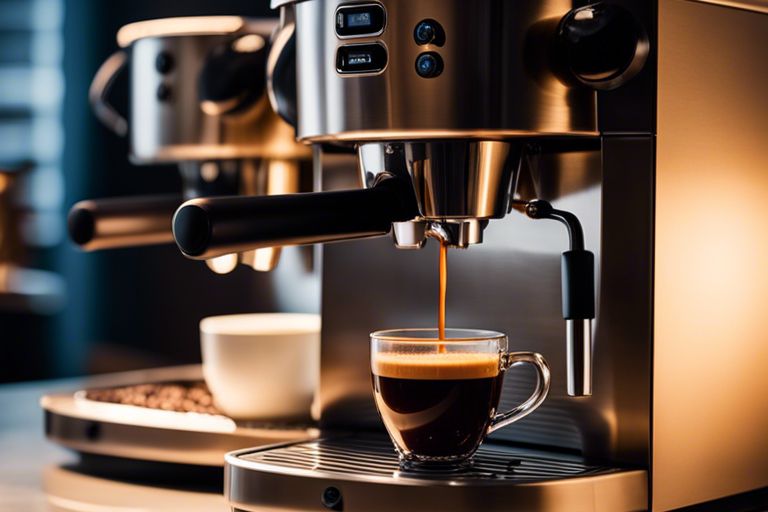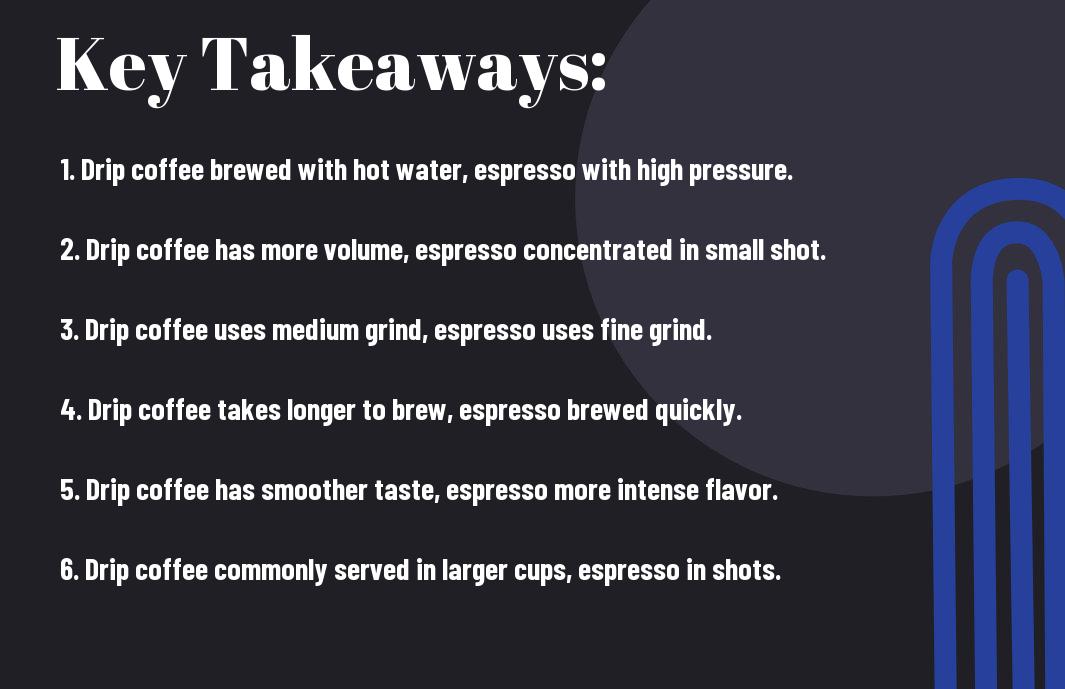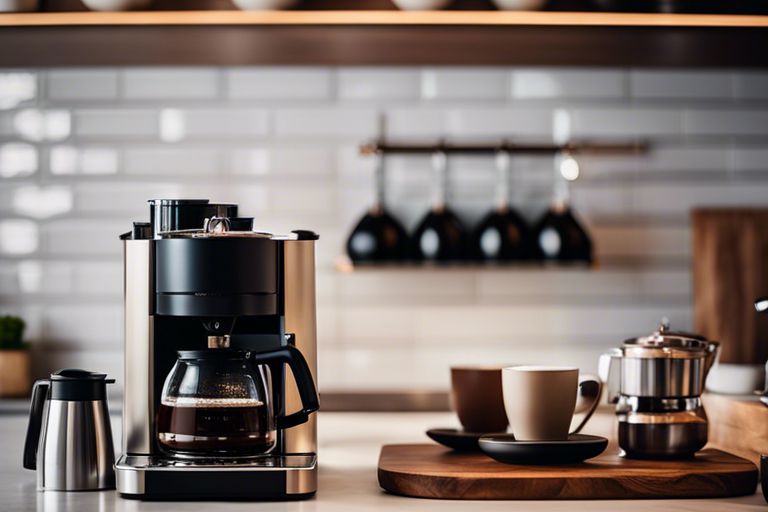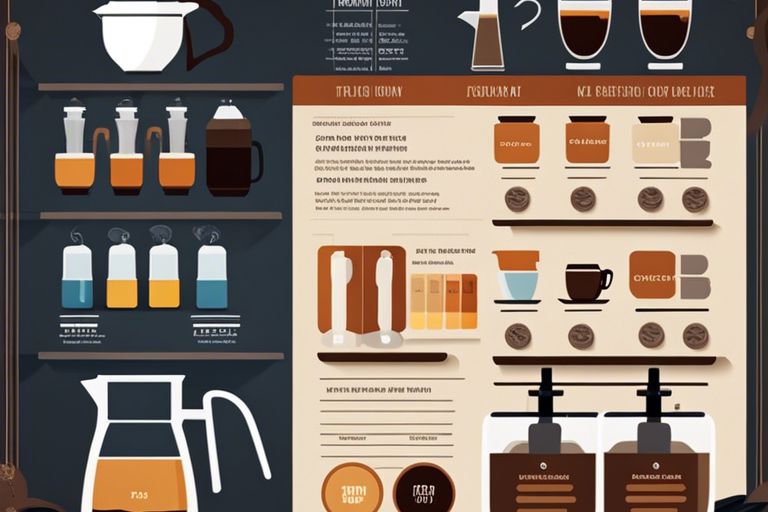Over the years, coffee lovers have been faced with the eternal question: drip or espresso? The answer lies in the way these two popular brews are prepared. Drip coffee, brewed by slowly pouring hot water over ground coffee beans, tends to be milder and more aromatic, while espresso, a concentrated shot made by forcing hot water through finely-ground coffee, packs a bold and intense flavor punch. So, whether you prefer a leisurely morning sip or a quick caffeine jolt, understanding the distinction between drip coffee and espresso is key to elevating your coffee experience.
Key Takeaways:
- Drip coffee: Drip coffee is made by slowly dripping hot water through ground coffee beans, resulting in a smoother and less intense flavor profile.
- Espresso: Espresso is a more concentrated coffee made by forcing pressurized hot water through finely-ground coffee beans, producing a strong and bold flavor with a thick crema on top.
- Extraction method: The main difference between drip coffee and espresso lies in the extraction method – drip coffee involves a longer extraction time, while espresso has a shorter and more pressurized extraction process.
David Sedaris might have joked that drip coffee is like a leisurely stroll through the park, while espresso is a shot of adrenaline straight to the heart – each serving its unique purpose in the caffeine-fueled world of coffee.

The Basics of Coffee
Your Espresso vs Drip Coffee blog post is bound to clear up confusion about these two popular coffee brewing methods. Let’s examine the crucials of drip coffee and espresso to get a better understanding of what sets them apart.
What is Drip Coffee?
What sets drip coffee apart is its method of preparation. Drip coffee involves hot water dripping through ground coffee beans in a filter. This process extracts the flavors and oils from the coffee grounds, resulting in a smooth and aromatic cup of coffee that many people are familiar with. Drip coffee is often brewed in larger quantities and is perfect for those who prefer a milder and less intense coffee taste.
What is Espresso?
Coffee enthusiasts often marvel at the distinct taste of espresso. This concentrated coffee is brewed by forcing a small amount of nearly boiling water through finely-ground coffee beans. The result is a rich and bold shot of coffee that can be enjoyed on its own or used as the base for other popular coffee beverages like lattes and cappuccinos. Espresso is known for its intense flavor profile and velvety crema layer on top, giving it a luxurious appeal.
A shot of espresso is a powerhouse of flavor, packed with a concentrated punch that awakens the senses and leaves a lingering taste that many coffee connoisseurs crave. The brewing process involved in making espresso requires precision and control over factors such as grind size, water temperature, and pressure. This careful balance ensures that each shot of espresso delivers a robust and flavorful experience that sets it apart from other coffee brewing methods.

Brewing Methods
How Drip Coffee is Made
Assuming you’re starting your day with a classic cup of drip coffee, you’ll witness the gradual and almost meditative process of brewing. Drip coffee is made by pouring hot water over ground coffee beans, allowing the water to pass through the grounds and then through a filter to extract the flavors. This method results in a lighter-bodied, smoother cup of coffee than espresso, perfect for leisurely sipping as you ease into your day.
How Espresso is Made
Methods for brewing espresso are quite different from drip coffee. When making espresso, hot water is forced through finely-ground coffee beans at high pressure, resulting in a concentrated and bold shot of coffee. This intense extraction process creates a rich and full-bodied coffee that is often consumed quickly in smaller amounts, making it perfect for a quick caffeine boost or a pick-me-up in the afternoon.
Plus, espresso serves as the foundation for a variety of popular coffee drinks, such as lattes, cappuccinos, and macchiatos. These espresso-based beverages combine the intensity of espresso with steamed milk or foam, creating a whole new world of coffee experiences beyond the traditional drip coffee.

Flavor Profiles
The Taste of Drip Coffee
For drip coffee, the flavor profile is typically milder and smoother compared to espresso. The brewing process for drip coffee involves water slowly dripping through a filter containing coffee grounds, allowing for a more gradual extraction of flavors.
The Taste of Espresso
For espresso, the flavor profile is intense and concentrated. The brewing method involves forcing hot water through finely-ground coffee beans at high pressure, resulting in a robust and full-bodied taste with a layer of rich crema on top.
Another characteristic of espresso is its versatility in creating a range of flavors depending on the coffee beans used, the roast level, and the brewing technique. From fruity and floral notes to chocolatey and nutty undertones, espresso offers a diverse and complex flavor experience.
Caffeine Content
How Much Caffeine in Drip Coffee?
To understand the caffeine content in drip coffee, we must consider that an average 8-ounce cup contains around 95 milligrams of caffeine. However, this amount can vary depending on factors such as the type of coffee beans, brewing method, and the strength of the brew. Generally, drip coffee tends to have a higher caffeine content than espresso due to the larger serving size.
How Much Caffeine in Espresso?
Much like drip coffee, the caffeine content in espresso can also vary. A typical 1-ounce shot of espresso contains approximately 63 milligrams of caffeine. Despite the smaller serving size compared to a cup of drip coffee, espresso is more concentrated, making it a potent source of caffeine.
Caffeine is extracted from the coffee grounds during the espresso brewing process, resulting in a strong and intense flavor profile. This concentrated form of coffee offers a quick caffeine boost, making it a popular choice for those seeking a powerful kick to start their day.
Equipment and Cost
Drip Coffee Makers: Options and Prices
Not everyone wants to spend a small fortune on their coffee equipment, and that’s where drip coffee makers come in. These machines are typically more affordable than espresso machines and come in a wide range of options to suit different budgets and preferences.
With drip coffee makers, you can find simple and budget-friendly models for as low as $20, while more advanced models with features like programmable settings and thermal carafes can range from $50 to $200 or more. The cost ultimately depends on the brand, features, and capacity of the machine.
Espresso Machines: Options and Prices
Drip coffee makers are versatile and budget-friendly, but if you’re a true coffee connoisseur looking to invest in a top-notch machine, espresso machines might be more up your alley. These machines are capable of making high-quality espresso and espresso-based drinks like lattes, cappuccinos, and macchiatos.
Espresso machines come in a wide price range, from around $100 for entry-level models to well over $1000 for high-end, commercial-grade machines. The cost can vary based on factors like the machine’s design, features, brewing capacity, and brand reputation.
Drip coffee makers are great for everyday coffee drinkers looking for a convenient and budget-friendly brewing option, while espresso machines cater to those who appreciate the art and science of espresso-making and are willing to invest in a more sophisticated brewing experience.
Cultural Significance
Now, when exploring the cultural significance of drip coffee and espresso, it is fascinating to examine the traditions and rituals associated with each brewing method. For a detailed comparison, you can refer to Espresso vs. Drip Coffee: How are They Different?
Drip Coffee Culture in the US
Drip coffee holds a special place in American culture, where it is often seen as a symbol of convenience and practicality. The ritual of brewing a pot of drip coffee every morning is a cherished routine for many Americans, providing a sense of comfort and familiarity to start the day.
Espresso Culture in Europe
Coffee culture in Europe, particularly in countries like Italy and France, revolves around espresso. The act of sipping a strong shot of espresso at a bustling cafe while standing at the bar is not just about caffeine intake but is a social experience that embodies the essence of European lifestyle and sophistication.
Cultural significance also extends to the design of cafes in Europe, where ornate espresso machines and elegant porcelain cups are crucial elements of creating an ambiance that celebrates the art of espresso making.
Summing up
Following this exploration of drip coffee and espresso, it is evident that the main difference lies in their brewing processes and the resulting taste and texture of the coffee. Drip coffee offers a milder flavor and more volume, making it a popular choice for those who prefer a less intense coffee experience. On the other hand, espresso is known for its bold and concentrated flavor, perfect for those who enjoy a strong caffeine kick.
As a final point, while both drip coffee and espresso have their unique characteristics, the choice between the two ultimately comes down to personal preference. Whether you prefer a leisurely cup of coffee to savor or a quick shot of intense espresso to kickstart your day, both options offer a delightful way to enjoy this beloved beverage.
FAQ
Q: What is the difference between drip coffee and espresso?
A: Drip coffee is made by slowly dripping hot water over ground coffee beans, producing a milder and smoother flavor. On the other hand, espresso is a strong and concentrated coffee made by forcing hot water through finely-ground coffee beans under high pressure.
Q: Is there a difference in caffeine content between drip coffee and espresso?
A: Yes, there is a difference in caffeine content between drip coffee and espresso. While drip coffee has more volume per serving, espresso has a higher concentration of caffeine due to its brewing method, resulting in a more intense caffeine kick.
Q: How are the brewing methods different for drip coffee and espresso?
A: Drip coffee is typically brewed using a coffee maker that drips hot water over a bed of ground coffee, allowing the liquid to pass through a filter and collect in a pot below. Espresso, on the other hand, is made using an espresso machine that forces pressurized water through finely-ground coffee, resulting in a small shot of concentrated coffee.
Q: What about the grind size and roast level for drip coffee and espresso?
A: Drip coffee requires a medium grind size and is best brewed with medium to dark roast beans to achieve a balanced flavor profile. Espresso, on the other hand, calls for a fine grind size and is often brewed with dark roast beans to enhance its bold and robust taste.
Q: Can you use the same beans for drip coffee and espresso?
A: While you can use the same type of coffee beans for both drip coffee and espresso, it is recommended to choose a roast level and grind size that is specific to each brewing method. This ensures that you get the best flavor and brewing results for each type of coffee.









